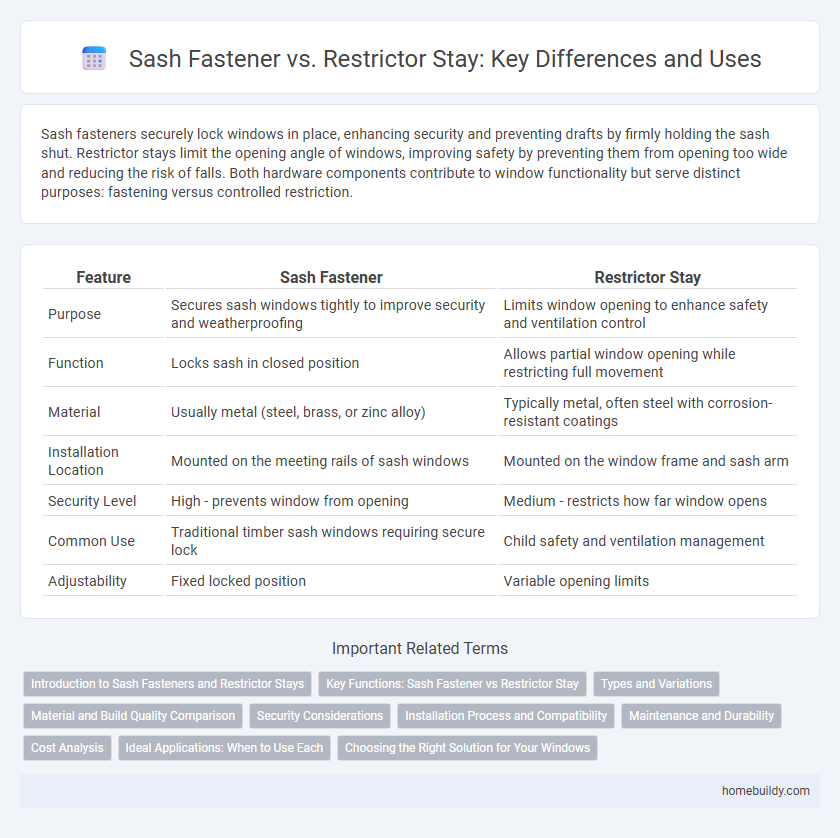Sash fasteners securely lock windows in place, enhancing security and preventing drafts by firmly holding the sash shut. Restrictor stays limit the opening angle of windows, improving safety by preventing them from opening too wide and reducing the risk of falls. Both hardware components contribute to window functionality but serve distinct purposes: fastening versus controlled restriction.
Table of Comparison
| Feature | Sash Fastener | Restrictor Stay |
|---|---|---|
| Purpose | Secures sash windows tightly to improve security and weatherproofing | Limits window opening to enhance safety and ventilation control |
| Function | Locks sash in closed position | Allows partial window opening while restricting full movement |
| Material | Usually metal (steel, brass, or zinc alloy) | Typically metal, often steel with corrosion-resistant coatings |
| Installation Location | Mounted on the meeting rails of sash windows | Mounted on the window frame and sash arm |
| Security Level | High - prevents window from opening | Medium - restricts how far window opens |
| Common Use | Traditional timber sash windows requiring secure lock | Child safety and ventilation management |
| Adjustability | Fixed locked position | Variable opening limits |
Introduction to Sash Fasteners and Restrictor Stays
Sash fasteners are hardware components designed to secure window sashes, providing a tight seal to enhance insulation and security. Restrictor stays limit the opening of windows for safety purposes, preventing accidents while allowing controlled ventilation. Choosing between sash fasteners and restrictor stays depends on the desired balance of security, ventilation, and safety needs for different window types.
Key Functions: Sash Fastener vs Restrictor Stay
Sash fasteners secure sash windows by locking the movable panels in place, providing enhanced security and weatherproofing. Restrictor stays limit the opening angle of the window to prevent falls or unauthorized access, prioritizing safety over full closure. Both components work together to balance security, ventilation, and safety in window systems.
Types and Variations
Sash fasteners come in various types including cockspur, monkey tail, and casement fasteners, each designed for secure window closure and enhanced aesthetics. Restrictor stays vary from friction, fixed, to adjustable models, offering controlled window opening for safety and ventilation. Both sash fasteners and restrictor stays feature multiple material options like brass, stainless steel, and zinc alloy, catering to different durability and design requirements.
Material and Build Quality Comparison
Sash fasteners are typically made from durable metals such as stainless steel or brass, ensuring robust corrosion resistance and long-lasting performance in various weather conditions. Restrictor stays often utilize lighter metals or alloys, which may offer less strength but provide flexibility for controlled window movement. High build quality in sash fasteners focuses on precision locking mechanisms and heavy-duty construction, whereas restrictor stays emphasize smooth pivoting joints and sufficient but lower load-bearing capacity.
Security Considerations
Sash fasteners provide enhanced security by firmly locking windows, reducing the risk of forced entry compared to restrictor stays, which primarily limit opening range without fully securing the sash. The sturdy construction and locking mechanism of sash fasteners offer better resistance against break-ins, making them ideal for high-security environments. Restrictor stays improve safety by preventing windows from opening too wide but should be combined with sash fasteners to maximize overall window security.
Installation Process and Compatibility
Sash fasteners typically require simple drilling and screwing into the sash frame, making their installation process straightforward and suitable for most timber and uPVC windows. Restrictor stays often involve more complex mounting points on both the sash and frame, requiring precise alignment and compatibility with hinged or top-opening window types. Compatibility varies as sash fasteners are versatile across standard double-hung or casement windows, while restrictor stays are designed primarily for safety and ventilation, limiting their use to certain window styles.
Maintenance and Durability
Sash fasteners typically require less maintenance due to their straightforward design and fewer moving parts, resulting in longer-lasting performance compared to restrictor stays. Restrictor stays often need regular lubrication and tightening to maintain functionality and prevent wear. The durability of sash fasteners is enhanced by corrosion-resistant materials, making them a preferred choice for long-term window security.
Cost Analysis
Sash fasteners generally offer a more cost-effective solution compared to restrictor stays due to their simpler design and easier installation process. While restrictor stays provide enhanced security and controlled ventilation, their higher manufacturing complexity and maintenance requirements increase overall costs. Investing in sash fasteners can significantly reduce upfront and long-term expenses for residential window fittings.
Ideal Applications: When to Use Each
Sash fasteners are ideal for securing double-hung or sliding windows, providing enhanced security and ease of use, especially in residential settings. Restrictor stays are better suited for controlling window opening limits in casement or awning windows, ensuring safety by preventing full opening in environments like schools or childcare centers. Choosing between the two depends on the window type and desired functionality, with sash fasteners focusing on locking mechanisms and restrictor stays emphasizing controlled ventilation and safety.
Choosing the Right Solution for Your Windows
Sash fasteners provide secure locking and enhanced security for traditional sash windows, ensuring a tight seal and improved weatherproofing. Restrictor stays allow controlled window opening for ventilation while preventing full extension, ideal for safety in homes with children or for ventilation control. Selecting between sash fasteners and restrictor stays depends on whether security or controlled ventilation is your primary requirement for window functionality.
Sash fastener vs Restrictor stay Infographic

 homebuildy.com
homebuildy.com